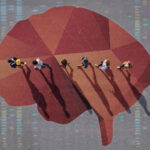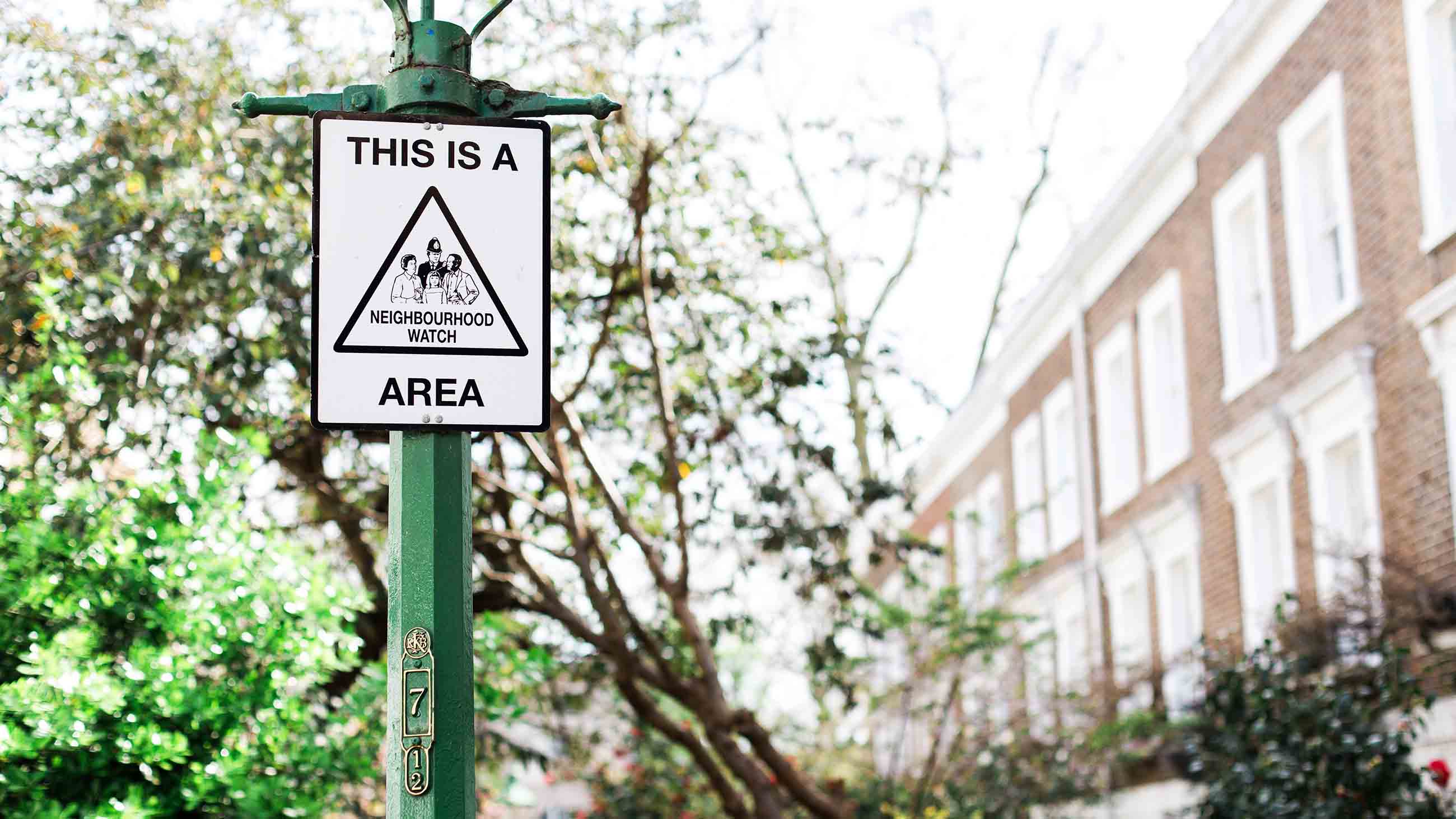Why Our Brains Constantly Create New Threats
Why do many problems in life seem to stubbornly stick around, no matter how hard people work to fix them? It turns out that a quirk in the way human brains process information means that when something becomes rare, we sometimes see it in more places than ever.

VIEWPOINTS
Partner content, op-eds, and Undark editorials.
Think of a “neighborhood watch” made up of volunteers who call the police when they see anything suspicious. Imagine a new volunteer who joins the watch to help lower crime in the area. When they first start volunteering, they raise the alarm when they see signs of serious crimes, like assault or burglary.
Let’s assume these efforts help and, over time, assaults and burglaries become rarer in the neighborhood. What would the volunteer do next? One possibility is that they would relax and stop calling the police. After all, the serious crimes they used to worry about are a thing of the past.
But you may share the intuition my research group had – that many volunteers in this situation wouldn’t relax just because crime went down. Instead, they’d start calling things “suspicious” that they would never have cared about back when crime was high, like jaywalking or loitering at night.
You can probably think of many similar situations in which problems never seem to go away, because people keep changing how they define them. This is sometimes called “concept creep,” or “moving the goalposts,” and it can be a frustrating experience. How can you know if you’re making progress solving a problem, when you keep redefining what it means to solve it? My colleagues and I wanted to understand when this kind of behavior happens, why, and if it can be prevented.
To study how concepts change when they become less common, we brought volunteers into our laboratory and gave them a simple task – to look at a series of computer-generated faces and decide which ones seem “threatening.” The faces had been carefully designed by researchers to range from very intimidating to very harmless.
As we showed people fewer and fewer threatening faces over time, we found that they expanded their definition of “threatening” to include a wider range of faces. In other words, when they ran out of threatening faces to find, they started calling faces threatening that they used to call harmless. Rather than being a consistent category, what people considered “threats” depended on how many threats they had seen lately.
This kind of inconsistency isn’t limited to judgments about threat. In another experiment, we asked people to make an even simpler decision: whether colored dots on a screen were blue or purple.
As blue dots became rare, people started calling slightly purple dots blue. They even did this when we told them blue dots were going to become rare, or offered them cash prizes to stay consistent over time. These results suggest that this behavior isn’t entirely under conscious control – otherwise, people would have been able to be consistent to earn a cash prize.
After looking at the results of our experiments on facial threat and color judgments, our research group wondered if maybe this was just a funny property of the visual system. Would this kind of concept change also happen with non-visual judgments?
To test this, we ran a final experiment in which we asked volunteers to read about different scientific studies, and decide which were ethical and which were unethical. We were skeptical that we would find the same inconsistencies in these kind of judgments that we did with colors and threat.
Why? Because moral judgments, we suspected, would be more consistent across time than other kinds of judgments. After all, if you think violence is wrong today, you should still think it is wrong tomorrow, regardless of how much or how little violence you see that day.
But surprisingly, we found the same pattern. As we showed people fewer and fewer unethical studies over time, they started calling a wider range of studies unethical. In other words, just because they were reading about fewer unethical studies, they became harsher judges of what counted as ethical.
Why can’t people help but expand what they call threatening when threats become rare? Research from cognitive psychology and neuroscience suggests that this kind of behavior is a consequence of the basic way that our brains process information – we are constantly comparing what is front of us to its recent context.
Instead of carefully deciding how threatening a face is compared to all other faces, the brain can just store how threatening it is compared to other faces it has seen recently, or compare it to some average of recently seen faces, or the most and least threatening faces it has seen. This kind of comparison could lead directly to the pattern my research group saw in our experiments, because when threatening faces are rare, new faces would be judged relative to mostly harmless faces. In a sea of mild faces, even slightly threatening faces might seem scary.
It turns out that for your brain, relative comparisons often use less energy than absolute measurements. To get a sense for why this is, just think about how it’s easier to remember which of your cousins is the tallest than exactly how tall each cousin is. Human brains have likely evolved to use relative comparisons in many situations, because these comparisons often provide enough information to safely navigate our environments and make decisions, all while expending as little effort as possible.
Sometimes, relative judgments work just fine. If you are looking for a fancy restaurant, what you count as “fancy” in Paris, Texas, should be different than in Paris, France.
But a neighborhood watcher who makes relative judgments will keep expanding their concept of “crime” to include milder and milder transgressions, long after serious crimes have become rare. As a result, they may never fully appreciate their success in helping to reduce the problem they are worried about. From medical diagnoses to financial investments, modern humans have to make many complicated judgments where being consistent matters.
How can people make more consistent decisions when necessary? My research group is currently doing follow-up research in the lab to develop more effective interventions to help counter the strange consequences of relative judgment.
One potential strategy: When you’re making decisions where consistency is important, define your categories as clearly as you can. So if you do join a neighborhood watch, think about writing down a list of what kinds of transgressions to worry about when you start. Otherwise, before you know it, you may find yourself calling the cops on dogs being walked without leashes.
David Levari is a postdoctoral researcher in psychology at Harvard University.
This article was originally published on The Conversation. Read the original article.











Comments are automatically closed one year after article publication. Archived comments are below.
Perception is learned. Depending upon the values taught in youth through traditional teaching of localization and experiences, each person will develop a base for judgment of good and bad. Regional perception will fluctuate due to regionally accepted behavior in every case study. Isolation of different beliefs instilled into the psyche regionally will bear weight on the determination of ethical and unethical judgments of other peoples from different regions. Only through making education of other cultures readily available in all areas can regional perception be changed to accepting or rejecting preordained decisions based on regional teachings. Deep-rooted beliefs based upon regional misconceptions may be reversed through revealing truths in mass scale. Correlating regional beliefs and exposing the differences created from misconception, deception, and manipulation to control the masses through the conceived perception of drastic differences. What one may consider moral and ethical, unthreatening, another may consider threatening and unethical all from taught thought processing. The convoluted status of multi demonizing of all who are different should be addressed. Using facts without personal perception to reeducate the world population could possible bring the species up one more level on the evolutionary ladder. These are just my thought. I am not an expert on anything. I just feel that beliefs have killed more humans than reasoning ever did kill. Facts and numbers are reliable. They speak the truth the same way every time. Using a system of checks and measures along with the scientific facts to actually educate instead of indoctrinating could possible make a better human race.
“. . . otherwise, people would have been able to be consistent to earn a cash prize.”
Suppose they didn’t appreciate this Pavlovian treatment. Maybe they were inconsistent in order to not validate – for their own reasons of self-esteem – being treated as Pavlov’s dog.
This appears to be exactly what we are seeing right now with the shifting definition of sexual harassment or assault. As more people report (or pile on), their descriptions of what happened appear less and less worth reporting. However, a alternative explanation might be that instead of the reports being less worthy, the public becomes more inured and decides that moderate levels of harassment are actually no big deal.
“… think about writing down a list…” What good would that do? How about “Write a list…” Surely the whole point is to get it out of ones’ [biased] head!
Greg Braden Quantum Physics The GOD Gene
I think I understand this theory. There are people who think crime is much worse “today” than in the past because of very heavily covered school shootings and mass shootings. The incidence of gun murders, other murders and violent crime is down in the last 20-30 years. In the “good old days” of the 30’s and 40’s when my mother was a young adult, the mob dominated our Florida city. At age 30, she witnessed a mobster being shot by an enemy a few cars ahead of hers, stopped at a traffic light.
This is a wonderful discussion from a policy standpoint. What are the economic and policy effects of the incorrect perception of risk? How much money is wasted trying to reduce threat levels to zero? As for the hope that AI can save us, if we have learned nothing else in 2018, we do know that we build our unconscious biases into our algorithms and machines.
It would be interesting to extend this to potential or real romantic partners. If the media increasingly propagates images and ideals of the ‘perfect partner’, it would make most normal people appear unattractive by comparison. But I guess this is already captured by social comparison theory.
It would also be interesting to extend this to self-assessment of personal qualities. A drug dealer could feel like a confident, dominant, tough, cool girl, just because of the people she hangs around, whereas in many other social circles she would just look like a weak loser. What about intelligence–are you surrounded by super intelligent people, or average people? Does that make you feel more or less intelligent, or confident about your intelligence? I guess the Dunning-Kruger effect–less intelligent people tend to overestimate their intelligence, and more intelligent people tend to overestimate others’ intelligence–could tie in to the intelligence bit.
The world isn’t static in case anyone else hasn’t noticed. Let’s see, over the 4th of July holiday, on 3 occasions they spotted a pedophile on the beach masturbating and that was reported by children. So that’s a real threat that changes moment to moment, wherever that one may be. If you aren’t paying attention this world has quite a few threats and characters in it. We have a POTUS that claims to be starting a tariff war to drive prices up to consumers. So take your pick, there are liars and criminals amongst us that have to rationalize inflation for their greed. They aren’t a fabricated threat, they are real from moment to moment. I mean take the Healthcare insurance people, they’re a financial threat with premium increases. We can keep on going with everyone on this planet that adversely effects your bottom line and any raise to offset that is a deficit spending effect for a wealth transfer. Sad the rest of us are in a reactionary mode. We can’t get rid of these people either. They’ve seized power.
I imagine this happens in marriage, too!?! No wonder we think, “he/she is never satisfied.”
This article is actually quite fascinating, even enlightening; because it is quite an obvious thing to point out being true, and yet, the sheer reading of it made it the most obvious for me.
Personally, I can note that if I have decided to hear out what is in the political media outlets, I do find myself quicker to prejudge folks that I might not all other times, and it is quite apparent this has happened over the last year or so. Likewise, it became easier to prejudge things like accidents being an at fault, rather than basic human error, just so to blame someone for them… Which clearly is not logical at all.
So I do support these kinds of “comparative” studies. Ones that don’t have an actual biased goal or outcome, but merely flip the sides consistently to see if folks have been able to “stay on their toes”. We actually do need to pay attention to these things in ourselves, there is absolutely no question about that front, and recognize that our brains are liable to change from outside sources, since it is certainly true that changing what we believe without personal will, can and will become a very dangerous thing… More than the crime or duress in the world we are so anxious to change or, for lack of better terms, “Make the world as best possible”… Because even that goal is, technically, a biased one depending on the angle.
Real kudos to this research, thank you.
As a teacher, I feel like the phenomenon described is more similar to how students guess on a multiple choice test, where some students will choose an option because it hasn’t occured frequently enough. Choices are based on an imagined probability, rather than a change in judgement. You could probably test this by breaking the rarity and making it more abundant for a short while before continuing the rarity again. I’d also be curious if rarity was switched after a while, so the other option becomes more rare after a while and the rare case becomes more abundant.
Also, I noticed that the tests are mostly looking for negatives (looking for crimes, threatening faces, unethical studies). I wonder if the same thing would happen if they were asked to find positives, like friendly faces, ethical studies.
So this at least partly explains why low crime areas are the most paranoia about crime, ascribing proximate threats to remotely located immigrants and minorities. And Trump stokes this fear with baseless claims about the criminality of immigrants.
People are scared of what is dramatic more then what is actually common. People far plane crashes more than car crashes, but they spend only a few hours a year in planes.
I think this article points to something that is the opposite of desensitization. If you see a lot of threatening faces, then ones that are threatening, but not as threatening, might look mild.
Lightweights aren’t just light people, sometimes they just lack experience. People soften up, people get out of shape, people become sensitive to things they wouldn’t normally be.
Explains why I keep getting excited about “limited time” offers/sales on products I already own.
In some cases this type of thinking is institutionalized. In law enforcement we are trained, and trained again, to see every situation as a potential threat, no matter how innocent. This mindset has no doubt saved lives in law enforcement, but it has also no doubt taken innocent lives on the street when people are shot reaching for a wallet, or cell phone, etc.
Exactly that is happening in many areas from shark attacks to airline crashes, or medical “alerts” when the threat is minimal. This is making everyone over anxious about nothing, and workers more paranoid and on edge waiting for a once in ten lifetimes event! Time to change a few things that make work increasingly unproductive and life more unpleasant and less enjoyable. Treykng to eliminate all risk is impossible, hugely uneconomic, and full of unintended consequences as the “analysis” is always flawed, incomplete, based on wrong or out of date data and made by the wrong people who ignore warnings from those on the ground. Tick box checklists etc increasingly creates without thinking doesn’t make you safer, nor do silly new rules and laws restricting reasonable human behaviour just because of one “imcident”. The worst ones are “black swan” events like 9/11, ulentirelt unpredictable and unpreventable, and dnithkngg we do will stop the next one becaus we have absolutely no idea chance at it will be! Enjoying and don’t stress about very unlikely events, or make others miserable by over regulation and mindless bureaucracy. Maybe AI can save us but probably not as it uses similar data ?